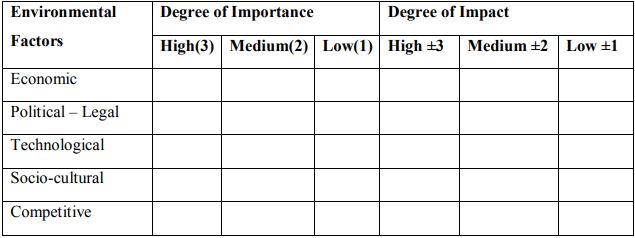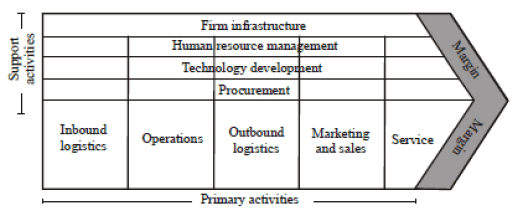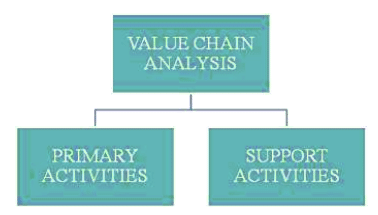Environmental Analysis and Internal Analysis | Management Optional Notes for UPSC PDF Download
| Table of contents |

|
| Strategic Analysis Models And Tools |

|
| Scanning The Environment |

|
| Environment Threat And Opportunity Profile |

|
| Value Chain Analysis |

|
Strategic Analysis Models And Tools
- Strategic analysis means thoroughly studying a company and its surroundings to come up with a plan.
- It involves looking at various factors that affect a company's strategy.
Key Steps:
Collecting Data: Finding and evaluating information that matters for the company's plans.
Understanding Environments: Figuring out what's happening inside and outside the company.
Analyzing Methods: Using different tools like Porter's five forces, SWOT analysis, and value chain analysis.
Why it Matters:
- Helps a company figure out how to grow and deal with industry challenges.
- Guides better decision-making for the company.
Simplified Approach:
- Strategic analysis is like making a roadmap for a company's future.
- It's about looking at what's going well and what could be a problem.
- We use special tools to understand the company and its surroundings better.
Scanning The Environment
Pestel Analysis
PESTEL analysis is a tool used to study and watch out for big factors outside a company that can strongly impact its performance.
It's super useful when a company is starting or going into a new country.
Purpose:
- It helps to find out what's happening around a company now.
- Identifies things that might change in the future.
- Aims to use these changes as opportunities or defend against them as threats, better than competitors.
1. Political Factors:
- Political factors encompass the influence of government policies and actions on businesses.
- This includes regulations, stability, trade policies, taxation policies, government intervention, and political stability.
- Political factors can significantly impact industries and businesses, especially those operating internationally or in heavily regulated sectors.
2. Economic Factors:
- Economic factors pertain to the broader economic conditions that can affect businesses.
- Elements such as economic growth, inflation rates, exchange rates, interest rates, unemployment rates, and disposable income of consumers fall under this category.
- These factors directly influence consumer spending patterns, business investment decisions, and overall market demand.
3. Social Factors:
- Social factors represent the characteristics, beliefs, attitudes, and lifestyles of the population.
- Demographic trends, cultural norms, values, population growth rates, age distribution, income distribution, and lifestyle choices are considered.
- Understanding social factors helps businesses tailor their products, services, and marketing strategies to specific target demographics.
4. Technological Factors:
- Technological factors refer to advancements, innovations, and changes in technology that can impact industries and markets.
- Factors such as R&D activities, automation, technological awareness, adoption rates, and disruptive technologies are analyzed.
- Businesses must adapt to technological changes to remain competitive and capitalize on emerging opportunities.
5. Environmental Factors:
- Environmental factors focus on ecological and environmental aspects that affect businesses.
- Concerns like climate change, weather patterns, natural disasters, environmental regulations, and sustainability initiatives fall under this category.
- Companies need to be mindful of their environmental footprint and align their operations with sustainable practices to meet regulatory requirements and consumer expectations.
6. Legal Factors:
- Legal factors encompass the laws, regulations, and legal frameworks that govern business operations.
- This includes employment laws, consumer protection laws, antitrust laws, intellectual property rights, health and safety regulations, and compliance requirements.
- Businesses must ensure compliance with legal requirements to avoid penalties, lawsuits, and reputational damage.
Importance of PESTEL Analysis:
- PESTEL analysis provides a comprehensive understanding of the external environment in which a business operates.
- It helps businesses anticipate changes, identify opportunities, and mitigate threats.
- By evaluating these factors, organizations can formulate strategic plans, make informed decisions, and adapt their strategies to changing market dynamics.
- PESTEL analysis is particularly valuable for new ventures, market entry strategies, and strategic planning processes.
Porter’s Five Forces Of Competitive Position Analysis
- Porter's Five Forces is a framework created by Michael E. Porter to assess the competitive strength and position of a business.
- It identifies five forces that shape the competitive landscape and attractiveness of a market.
- Helps to understand where power lies in a business scenario and evaluate competitive positions.
The Five Forces:
Supplier Power:
- Determines how easily suppliers can increase prices.
- Factors include the number of suppliers, uniqueness of their products, and switching costs for buyers.
Buyer Power:
- Assess how easily buyers can lower prices.
- Considerations include the number of buyers, their importance, and switching costs for buyers.
Competitive Rivalry:
- Reflects the number and strength of competitors.
- More competitors offering similar products reduce market attractiveness.
Threat of Substitution:
- Indicates the likelihood of customers switching to alternatives.
- Close substitutes decrease supplier power and market attractiveness.
Threat of New Entry:
- Examines the potential for new competitors entering the market.
- Profitable markets attract new entrants, reducing profitability unless there are barriers to entry.
Environment Threat And Opportunity Profile
- ETOP is a method to organize and understand the business environment. It was created by Glueck.
- It gives a summary of factors outside a business that can affect it, helping managers make strategic decisions.
Process:
- ETOP divides the environment into different sections and looks at the impact of each factor on the organization.
- It can be detailed, breaking down each section into smaller factors, or summarized, focusing on the major ones.

Important Dimension to Consider:
Issue Selection:
- Managers should focus on important issues like market share, pricing, customer preferences, tech changes, and economic policies.
- Selecting the right issues is crucial to avoid incorrect priorities.
Accuracy of Data:
- Collect data from reliable sources to ensure the analysis is meaningful.
- Consider factors like relevance, importance, manageability, variability, and low cost of data.
Impact Studies:
- Study the impact of opportunities and threats on the company's strengths, weaknesses, competitive position, and overall mission.
- Strive for objective assessments to make informed decisions.
Flexibility in Operations:
- Acknowledge uncertainties in business situations.
- Companies benefit from being proactive and flexible in their plans, structures, and strategies.
- Maintaining an optimum level of flexibility is crucial.
Increasing flexibility in an organization involves several essential elements:
- Clearly articulate the flexibility strategy so that managers can easily embrace it in unique situations.
- Regularly review and modify strategies as needed to ensure they remain effective.
- Anticipate and address exceptions to established strategies in advance. This allows managers to deviate from strategies when necessary.
- While flexibility may incur costs for implementing changes and adjusting plans, it is crucial for organizations to be agile and responsive in meeting urgent challenges.
Value Chain Analysis
- Value chain analysis is a business management strategy that dissects a company's activities into primary and support activities to understand how they contribute to the creation of value for the final product or service.
Purpose and Significance:
- The primary purpose is to identify areas of a company's operations that contribute to its competitive strength.
- By understanding the value chain, businesses can make strategic decisions to optimize processes, reduce costs, and enhance differentiation.

Michael Porter's Classification:
- Michael Porter categorized the value chain into nine activities that are interrelated and contribute to a company's overall competitiveness.
Classification of Value Chain Analysis
Value Chain Analysis is grouped into primary or line activities, and support activities discussed as under:

Primary Activities
Inbound Logistics:
- Involves receiving, storing, and distributing inputs (raw materials, components, etc.) needed for production.
Operations:
- Focuses on the actual transformation of inputs into final products through activities such as machining, assembling, and packaging.
Outbound Logistics:
- Manages the collection, storage, and delivery of finished products to customers.
Marketing and Sales:
- Encompasses all activities related to promoting, advertising, selling, and creating demand for products or services.
Service:
- Provides post-sale services to customers to maintain or enhance the value of the product. Includes after-sales support, financing, etc.
Support Activities
Procurement:
- Involves the acquisition of inputs like materials and machinery necessary for primary activities.
Technology Development:
- Focuses on research and development to improve technology, offering a competitive edge.
Human Resource Management:
- Oversees activities related to staff selection, retention, promotion, transfer, performance appraisal, and dismissal.
Infrastructure:
- Provides essential management services to the entire organization, including planning, finance, information management, quality control, legal, and government affairs.
Focus Areas for Analysis:
Issue Selection:
- Clearly define the strategy for flexibility in unique situations.
- Regularly review and modify strategies as required.
- Anticipate and handle exceptions to strategies beforehand.
Accuracy of Data:
- Collect data from reliable sources to ensure meaningful environmental scanning.
- Consider factors such as relevance, importance, manageability, variability, and low data cost.
Impact Studies:
- Conduct impact studies focusing on opportunities, threats, and critical issues.
- Evaluate effects on strengths, weaknesses, competitive position, mission, and vision.
Flexibility in Operations:
- Acknowledge uncertainties and devise proactive and flexible strategies in plans, structures, and operations.
- Maintain an optimum level of flexibility.
FAQs on Environmental Analysis and Internal Analysis - Management Optional Notes for UPSC
| 1. What is the purpose of strategic analysis models and tools? |  |
| 2. How does scanning the environment contribute to strategic analysis? |  |
| 3. What is an Environment Threat and Opportunity Profile (ETOP)? |  |
| 4. How does value chain analysis contribute to strategic analysis? |  |
| 5. What is the significance of environmental analysis and internal analysis in strategic analysis? |  |














